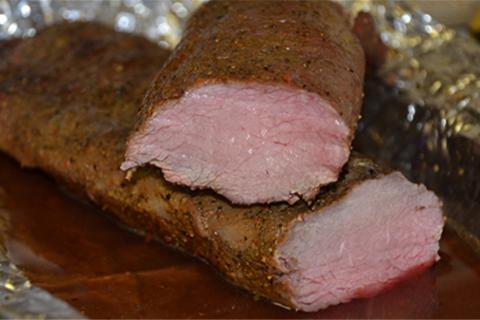
The Choicest Cut of Deer, Elk, Moose
The backstrap, or loin, of a deer, elk, moose or other big-game animal is considered the choicest cut. Because the long, lean muscle does not do a lot of work while the animal is alive, it is extremely tender, yet more flavorful than the tenderloin, which is butter soft but, in my opinion, bland. On a cow, the loin is where the steaks come from and on hogs, it is the chops. These same cuts can be re-created with venison with just a sharp knife and some basic knowledge.
Here are the Three Best Ways to Butcher a Backstrap.
1. Chateaubriand Fillets
Technically, this cut is from the thickest end of a tenderloin of beef, but hunters can make a reasonably similar chateaubriand from a deer or elk backstrap. It is not only the quickest way to butcher this long strip of prime, tender meat, it also creates larger steaks that are more forgiving on the grill. Simply divide and cut the backstrap up into three or four large chunks (or even five on bigger elk and moose). Leave these pieces whole and cook them as you would a steak or prime rib. The cooking time will be a bit longer, but they will stay moist on the inside and allow enough time to get a good char on the exterior of the cut.
Tip: Chateaubriand is a dish that traditionally consists of a large center cut fillet of tenderloin grilled between two lesser pieces of meat that are discarded after cooking. Wikipedia
2. Steaks - Many Hunters Choose to Butcher the Backstrap
Just like beef, the best steaks come from this long cut and many hunters choose to butcher their backstraps accordingly. The best thing about doing it yourself is you can cut the steaks just how thick you want. If it helps, think of a venison loin just like that from a cow and cut accordingly. Toward the rear of the backstrap comes your strip steak or top loin steak. Next, in the middle and front sections are the equivalent to a rib-eye or rib steak. Typically, the most tender cuts are from the center, with the front end of the backstrap near the neck a bit tougher than the rear.
3. Butterfly Chops - the Go-To Cut
I believe this is how most butchers cut venison backstraps unless the hunter requests something different. It is also the go-to cut from most home processors as it creates thin chops when spread open. First, make a cut just about through the backstrap at the thickness you want your chop. Do not cut all the way through, however. You want a thin flap of meat still connected. Next, slice the chop from the rest of loin at the same thickness. This will create a chop that is shaped like a butterfly once it is folded open, hence the name.
- 6031 views

